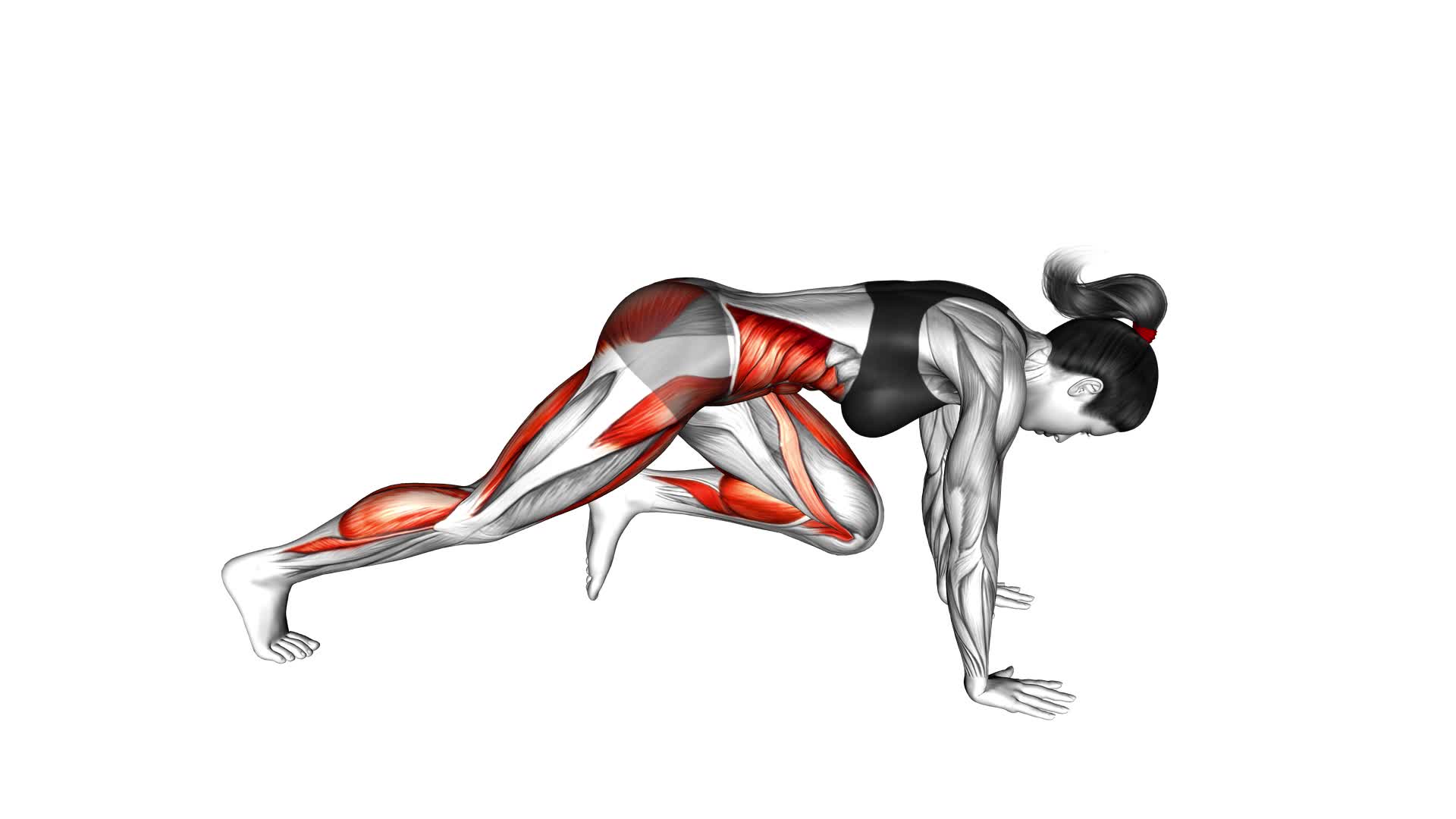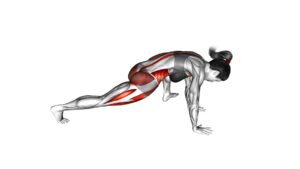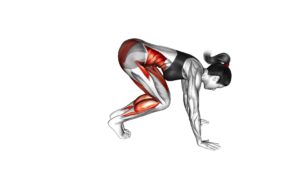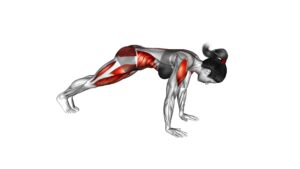Mountain Climber (VERSION 2) (female) – Video Exercise Guide & Tips

Get ready to conquer the mountains with this female version of the mountain climber exercise!
Watch This Exercise Video
In this video exercise guide, we'll show you the proper form and technique to maximize your workout.
Plus, we'll share variations to challenge yourself and tips to optimize your mountain climber routine.
Say goodbye to common mistakes and hello to a stronger, fitter you.
Let's climb those mountains together!
Key Takeaways
- The mountain climber exercise engages multiple muscle groups and helps burn calories.
- Proper form and technique include starting in plank position, maintaining a steady pace, and avoiding lifting buttocks too high or sinking them too low.
- There are variations of the mountain climber exercise, such as the Spiderman mountain climber and mountain climber with sliders, to challenge oneself.
- To optimize the mountain climber workout, engage core muscles, maintain a steady pace, control breathing, and increase intensity if desired.
Benefits of the Mountain Climber Exercise
To maximize your workout, incorporate the mountain climber exercise for its fat-burning and core-strengthening benefits. The mountain climber exercise is highly effective in engaging multiple muscle groups, including your abs, shoulders, and legs. Not only does it help you burn calories, but it also improves your cardiovascular endurance.
One of the great things about the mountain climber exercise is that it can be modified to suit your fitness level. If you're a beginner, you can start by performing the exercise at a slower pace and with shorter intervals. As you gain strength and stamina, you can increase the speed and duration of each rep.
To increase the intensity of your mountain climbers, you can try adding a twist to the exercise. Instead of bringing your knees straight up to your chest, bring them towards the opposite elbow. This rotational movement engages your obliques and adds an extra challenge to the exercise.
Another modification you can make is to elevate your feet. By placing your feet on an elevated surface, such as a step or bench, you increase the demand on your core and upper body.
Incorporating these modifications and increasing the intensity of your mountain climbers will help you achieve better results and take your workout to the next level. Remember to listen to your body and progress gradually to avoid injury.
Proper Form and Technique for the Mountain Climber
To perform the mountain climber exercise with proper form and technique, ensure that your body is in a plank position. Start by getting into a high plank position, with your hands directly under your shoulders and your legs extended straight behind you. Engage your core and keep your back flat throughout the exercise.
Once in the plank position, bring one knee forward towards your chest, keeping your foot off the ground. As you return that leg back to the starting position, simultaneously bring the other knee forward. Continue alternating knees in a quick, running motion.
Maintain a steady pace and be mindful of your form. Keep your hips level and avoid lifting your buttocks too high or sinking them too low. Also, be careful not to let your shoulders hunch or your back sag.
If you need to modify the mountain climber exercise, you can perform it with your hands on an elevated surface, such as a bench or step. This will reduce the strain on your wrists and shoulders.
If you're looking for alternatives to the mountain climber, you can try exercises like the plank, the bicycle crunch, or the burpee. These exercises provide similar benefits and can help you achieve a strong core and cardiovascular endurance.
Variations to Challenge Yourself With the Mountain Climber
Challenge yourself with different variations of the mountain climber exercise to make it more intense and engaging. There are several modifications and advanced variations you can try to challenge your body and take your mountain climber workout to the next level.
One modification you can try is the Spiderman mountain climber. Instead of bringing your knee straight forward, you can bring it out to the side, towards your elbow. This variation adds an extra twist to the exercise, engaging your obliques and core muscles even more.
Another modification is the mountain climber with sliders. Instead of placing your feet on the ground, you can use sliders or towels under your feet and slide them in and out. This variation requires more stability and control, making it more challenging for your core and upper body.
For advanced mountain climber variations, you can try the cross-body mountain climber. In this variation, instead of bringing your knee to the same side elbow, you bring it across your body to the opposite elbow. This engages your obliques and core muscles in a different way, making it more challenging and effective.
By incorporating these mountain climber modifications and advanced variations into your workout routine, you can continue to challenge yourself and see progress in your strength and endurance.
Now, let's move on to some tips to optimize your mountain climber workout.
Tips to Optimize Your Mountain Climber Workout
Are you wondering how to maximize the effectiveness of your mountain climber workout? Here are some tips to help you optimize your workout and achieve better results:
- Engage your core: During mountain climbers, focus on tightening your abdominal muscles. This won't only improve your core strength but also help stabilize your body and maintain proper form throughout the exercise.
- Maintain a steady pace: To increase cardiovascular endurance, try to keep a consistent and rhythmic pace during your mountain climber workout. This will challenge your heart and lungs, leading to improved stamina over time.
- Control your breathing: Proper breathing technique is essential for any workout. Inhale deeply as you bring your knee towards your chest, and exhale as you extend your leg back. This will help oxygenate your muscles and improve your overall performance.
- Increase the intensity: To further enhance the effectiveness of your mountain climber workout, you can try incorporating variations such as adding a push-up in between each rep or wearing ankle weights. These modifications will intensify the exercise and provide an extra challenge for your muscles.
By implementing these tips, you can optimize your mountain climber workout and see improvements in both your core strength and cardiovascular endurance.
Keep pushing yourself and enjoy the benefits of this versatile and challenging exercise.
Common Mistakes to Avoid While Doing the Mountain Climber
Avoid these common mistakes while doing the mountain climber to ensure proper form and maximize the benefits of the exercise.
One common mistake is rushing through the movement. It's important to maintain control and perform each rep with precision.
Another mistake is allowing your hips to rise too high or sag too low. Keep your body in a straight line from head to toe, engaging your core muscles to stabilize yourself.
Modifications can be made for those who struggle with the traditional mountain climber. If you find it difficult to maintain stability, try doing the exercise with your hands on an elevated surface, such as a bench or step. This will reduce the amount of weight you have to support and make it easier to perform the movement correctly.
On the other hand, if you want to challenge yourself and progress in your mountain climber workout, there are a few options. One progression is to increase the speed of your movements, performing the exercise at a faster pace. Another progression is to add a push-up between each leg movement, increasing the difficulty and engaging your upper body muscles even more.
Sample Mountain Climber Workout Routine
Now, let's take a look at a sample mountain climber workout routine.
This routine will help you experience the benefits of mountain climbers, explore different variations, and ensure you maintain proper form throughout the exercise.
Benefits of Mountain Climbers
Get ready to experience the numerous benefits of incorporating mountain climbers into your workout routine. Mountain climbers offer a range of advantages, including:
- Core strength: Mountain climbers engage your core muscles, helping to improve stability and overall core strength.
- Cardiovascular fitness: This exercise gets your heart rate up, providing a great cardiovascular workout.
- Full body workout: Mountain climbers work multiple muscle groups simultaneously, including your arms, shoulders, legs, and glutes.
- Versatility: Mountain climbers can be modified to suit different fitness levels and goals. You can adjust the intensity by increasing or decreasing the speed or adding variations like bringing your knees to the opposite elbow or performing them on an unstable surface.
Variations of Mountain Climbers
To continue exploring the benefits of mountain climbers, let's delve into various variations of this exercise, tailored specifically for your workout routine.
Mountain climber modifications can help you target different muscle groups and add variety to your workouts. One modification you can try is the side-to-side mountain climber, where you bring your knee towards the opposite elbow, engaging your obliques.
Another option is the spider mountain climber, where you bring your knee towards your elbow on the same side, challenging your core stability.
For those looking for more advanced mountain climber variations, you can try the mountain climber with a push-up or the mountain climber with a knee tuck. These variations add an extra challenge by incorporating upper body strength and core stability.
Incorporating these variations into your routine can help you continuously progress and achieve your fitness goals.
Tips for Proper Form
For proper form during your mountain climber workout routine, make sure to focus on maintaining a strong plank position while engaging your core and driving your knees towards your chest. This won't only help you improve stability but also increase core strength.
Here are some tips to ensure you're performing the exercise correctly:
- Keep your hands directly under your shoulders and your feet hip-width apart.
- Engage your core by pulling your belly button towards your spine.
- Avoid sagging or arching your back by keeping it straight and aligned.
- Maintain a steady pace and avoid rushing the movement to maintain control and maximize the benefits.
Frequently Asked Questions
Can Mountain Climbers Help With Weight Loss?
Mountain climbers can definitely help with weight loss. They're a great exercise for beginners as they work multiple muscle groups and elevate your heart rate. By engaging your core, arms, and legs, mountain climbers burn calories and promote fat loss.
Additionally, they improve cardiovascular endurance and increase overall strength. Incorporating mountain climbers into your workout routine can be an effective way to shed pounds and improve your fitness level.
Is It Safe to Do Mountain Climbers if You Have a Knee Injury?
If you have a knee injury, it's important to consider the safety of doing mountain climbers.
Mountain climbers can put strain on your knees, so it's crucial to modify the exercise to avoid aggravating your injury.
Instead of placing weight on your knees, try doing the exercise on an elevated surface or using a stability ball for support.
Always listen to your body and consult with a healthcare professional before attempting any exercise with a knee injury.
How Many Calories Can You Burn During a Mountain Climber Workout?
During a mountain climber workout, you can burn a significant amount of calories due to its high intensity level. The number of calories burned will depend on various factors such as your weight, duration of the workout, and intensity.
Mountain climbers are a great way to engage multiple muscle groups and increase your heart rate, leading to increased calorie burn. Remember to maintain proper form and listen to your body to avoid any potential injuries.
Can Mountain Climbers Help Improve Core Strength?
Mountain climbers are an excellent exercise choice for improving core strength. By engaging your abdominal muscles, mountain climbers help you develop a strong and stable core. This not only enhances your balance but also increases your flexibility.
The repetitive movement of the exercise activates your core muscles, making them stronger over time. So, if you're looking to strengthen your core and improve your balance and flexibility, mountain climbers are a great option.
Are There Any Modifications for Beginners to Do Mountain Climbers?
If you're a beginner, there are a few modifications you can do for mountain climbers. Start by placing your hands on an elevated platform, like a step or bench, instead of the floor. This will reduce the intensity and make it easier to perform.
Additionally, focus on maintaining proper form throughout the exercise. Common mistakes include sagging hips or rounding the back. Keep your core engaged and your body in a straight line to maximize the benefits.
Conclusion
In conclusion, the mountain climber exercise is a highly beneficial workout that targets multiple muscle groups and improves overall strength and endurance.
By maintaining proper form and technique, you can maximize the effectiveness of this exercise. Additionally, incorporating variations and following helpful tips can enhance the challenge and optimize your workout.
Be mindful of common mistakes to avoid injury. Try incorporating the sample mountain climber workout routine into your fitness regimen for a full-body workout.

Author
Years ago, the spark of my life’s passion ignited in my mind the moment I stepped into the local gym for the first time. The inaugural bead of perspiration, the initial endeavor, the very first surge of endorphins, and a sense of pride that washed over me post-workout marked the beginning of my deep-seated interest in strength sports, fitness, and sports nutrition. This very curiosity blossomed rapidly into a profound fascination, propelling me to earn a Master’s degree in Physical Education from the Academy of Physical Education in Krakow, followed by a Sports Manager diploma from the Jagiellonian University. My journey of growth led me to gain more specialized qualifications, such as being a certified personal trainer with a focus on sports dietetics, a lifeguard, and an instructor for wellness and corrective gymnastics. Theoretical knowledge paired seamlessly with practical experience, reinforcing my belief that the transformation of individuals under my guidance was also a reflection of my personal growth. This belief holds true even today. Each day, I strive to push the boundaries and explore new realms. These realms gently elevate me to greater heights. The unique combination of passion for my field and the continuous quest for growth fuels my drive to break new ground.







